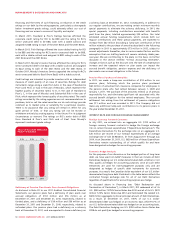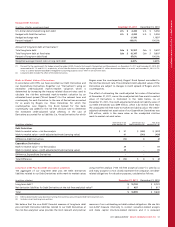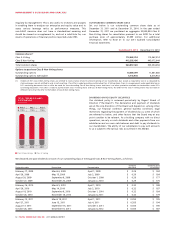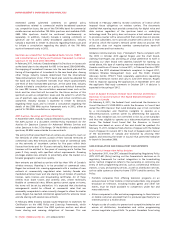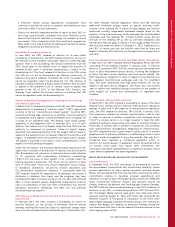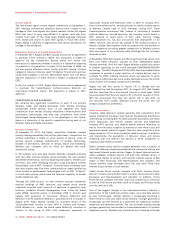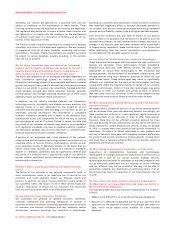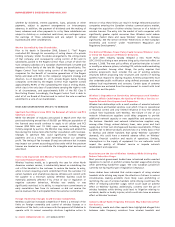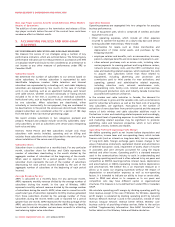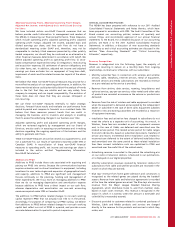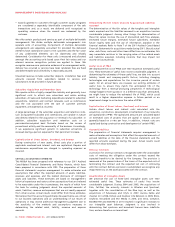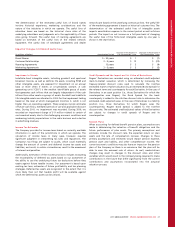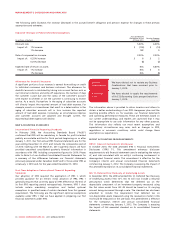Rogers 2011 Annual Report Download - page 63
Download and view the complete annual report
Please find page 63 of the 2011 Rogers annual report below. You can navigate through the pages in the report by either clicking on the pages listed below, or by using the keyword search tool below to find specific information within the annual report.
MANAGEMENT’S DISCUSSION AND ANALYSIS
the large majority of homes today continue to use standard home
telephone service. In addition, wireless Internet service is increasing in
popularity.
Video competes with DVD and video game sales and rental store
chains, as well as individually owned and operated outlets and, more
recently, on-line-based subscription rental services, on demand
services over cable and satellite, and illegally downloaded content as
well as distributors of copied DVDs. Competition is principally based
on location, price and availability of titles.
Media Competition
Rogers’ radio stations compete with the other stations in their
respective markets as well as with other media, such as newspapers,
magazines, television, outdoor advertising and digital properties.
Competition within the radio broadcasting industry occurs primarily
in individual market areas, amongst individual stations. On a national
level, Media’s radio division competes generally with other larger
radio operators, which own and operate radio station clusters in
markets across Canada. New technologies, such as on-line web
information services, music downloading, MP3 players and on-line
music streaming services, provide competition for radio stations’
audience share.
The Shopping Channel competes with various retail stores, catalogue
retailers, Internet retailers and direct mail retailers for sales of its
products. On a broadcasting level, The Shopping Channel competes
with other television channels for channel placement, viewer
attention and loyalty, and particularly with infomercials selling
products on television.
The Canadian magazine industry is highly competitive, competing for
both readers and advertisers. This competition comes from other
Canadian magazines and from foreign, mostly U.S. titles that sell in
significant quantities in Canada. On-line information and
entertainment websites compete with the Canadian magazine
publications for readership and revenue.
Rogers’ conventional television and specialty services compete
principally for viewers and advertisers with other Canadian television
stations that broadcast in their local markets, specialty channels and
increasingly with other distant Canadian signals and U.S. border
stations given the time-shifting capacity available to digital
subscribers. Internet information and entertainment and video
downloading also represent competition for share of viewership.
Sports Entertainment competes with other Toronto professional
teams for audience. The Blue Jays also compete with other Major
League Baseball teams for players and fan base. The Rogers Centre
competes with other local sporting and special event venues.
RISKS AND UNCERTAINTIES AFFECTING OUR BUSINESSES
Our business is subject to risks and uncertainties that could result in a
material adverse effect on our business and financial results. The
strategies to mitigate risks are the responsibility of many levels of the
organization to ensure that an appropriate balance is maintained
between seizing new opportunities and managing risk. Our culture
and policies support the requirement for risk management.
Our Board is responsible, in its governance role, for overseeing
management in its responsibility for identifying the principal risks of
our businesses and the implementation of appropriate risk assessment
processes to manage these risks. The Audit Committee supports the
Board through its responsibility to discuss policies with respect to risk
assessment and risk management. In addition, it is responsible for
assisting the Board in the oversight of compliance with legal and
regulatory requirements. The Audit Committee also reviews with
senior management the adequacy of the internal controls that we
have adopted to safeguard assets from loss and unauthorized use, to
prevent, deter and detect fraud, and to verify the accuracy of the
financial records and review any special audit steps adopted in light
of material weaknesses or significant deficiencies.
Our Enterprise Risk Management Group supports the Audit
Committee and the Board’s responsibility for risk by facilitating a
formal Strategic Risk Assessment process. In addition, our Internal
Audit Group conducts a fraud risk assessment to identify those areas
in which significant financial statement fraud could occur and ensure
that any identified fraud risks of this nature are mitigated by
documented and verified controls. Rogers Enterprise Risk
Management methodology and policies enable a consistent and
measurable approach to risk management, which relies on the
expertise of our management and employees to identify risks and
opportunities as well as implementing risk mitigation strategies as
required.
A discussion of the risks and uncertainties to us and our subsidiaries,
as well as a discussion of the specific risks and uncertainties associated
with each of our businesses, is presented below.
RISKS AND UNCERTAINTIES APPLICABLE TO RCI AND OUR
SUBSIDIARIES
We Face Substantial Competition.
The competition facing our businesses is described in the section
entitled “Competition in our Businesses”. There can be no assurance
that our current or future competitors will not provide services
superior to those we provide, or at lower prices, adapt more quickly
to evolving industry trends or changing market requirements, enter
the market in which we operate, or introduce competing services. Any
of these factors could reduce our market share or decrease our
revenue or increase churn. Wireless anticipates some ongoing
re-pricing of the existing subscriber base as lower pricing offered to
attract new customers is extended to or requested by existing
customers. As wireless penetration of the population deepens, new
wireless customers may generate lower average monthly revenues
than those generated from existing customers, which could slow
revenue growth.
In addition, the CRTC Broadcasting Distribution Regulations do not
allow Cable or its competitors to obtain exclusive contracts in
buildings where it is technically feasible to install two or more
systems.
Changes in Government Regulations Could Adversely Affect Our
Results of Operations in Wireless, Cable and Media.
As described in the section of this MD&A entitled “Government
Regulation and Regulatory Developments”, substantially all of our
business activities are regulated by Industry Canada and/or the CRTC,
and accordingly our results of operations on a consolidated basis
could be adversely affected by changes in regulations and by the
decisions of these regulators. This regulation relates to, among other
things, licencing, competition, the cable television programming
services that we must distribute, wireless and wireline interconnection
agreements, the rates we may charge to provide access to our
network by third parties, resale of our networks and roaming on to
our networks, our operation and ownership of communications
systems and our ability to acquire an interest in other communications
systems. In addition, the costs of providing services may be increased
from time to time as a result of compliance with industry or legislative
initiatives to address consumer protection concerns or such Internet-
related issues as copyright infringement, unsolicited commercial
e-mail, cyber-crime and lawful access. Our cable, wireless and
broadcasting licences may not generally be transferred without
regulatory approval.
2011 ANNUAL REPORT ROGERS COMMUNICATIONS INC. 59



